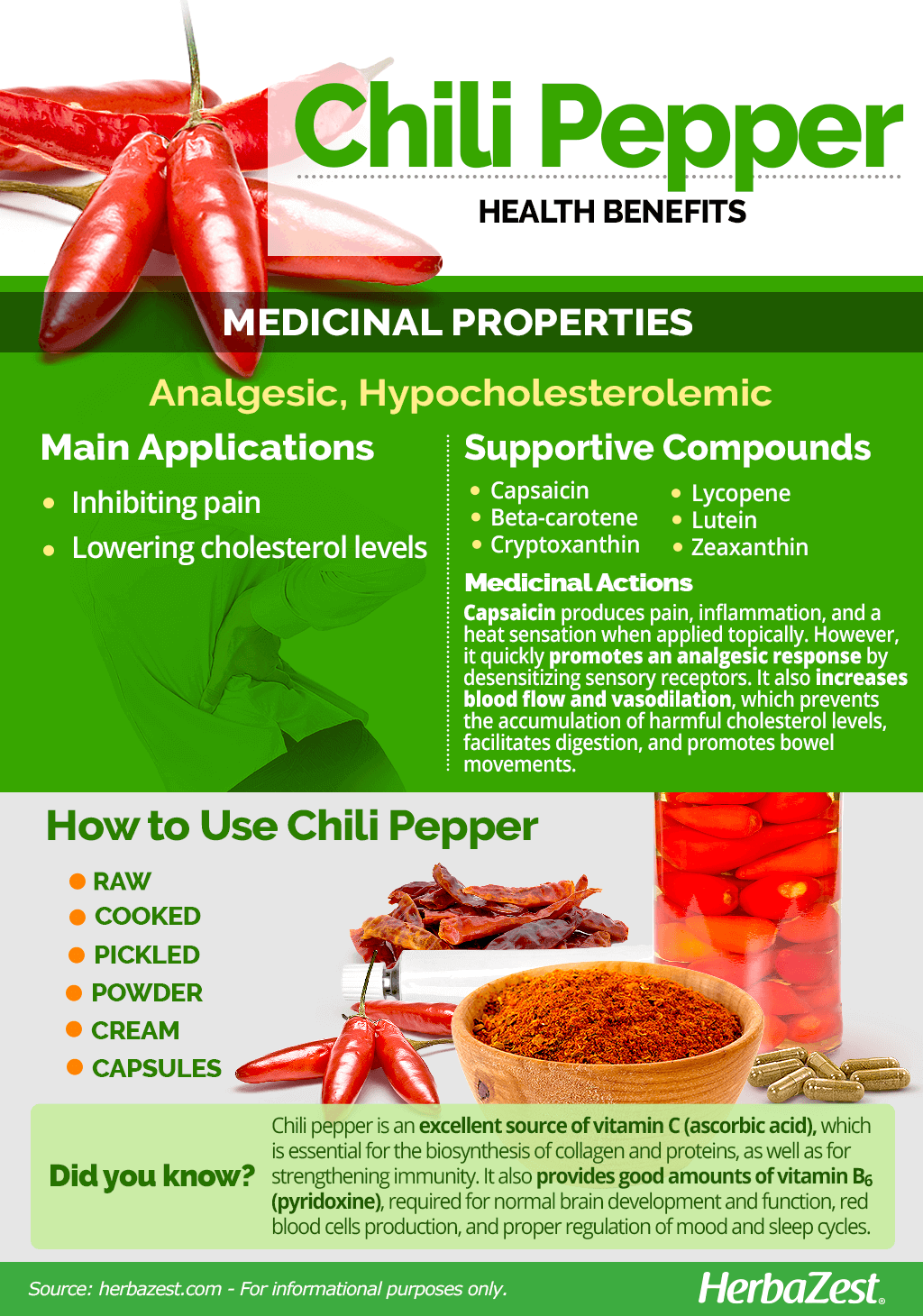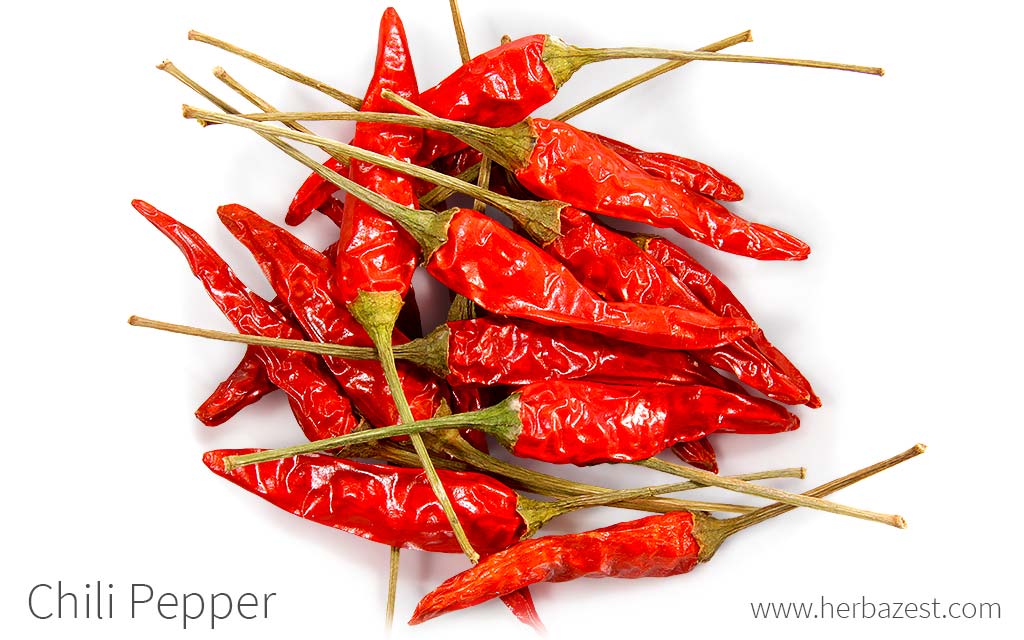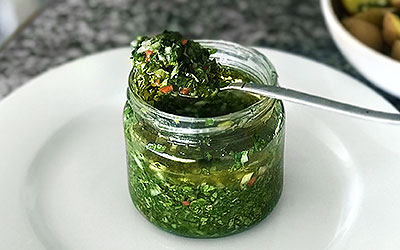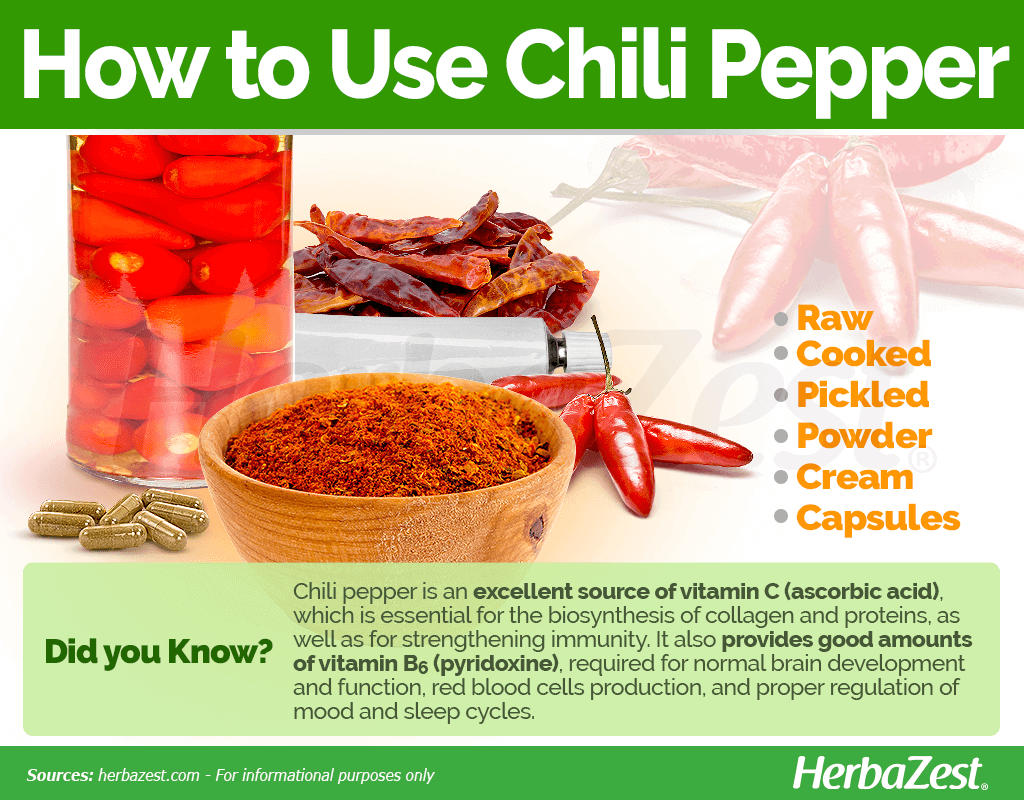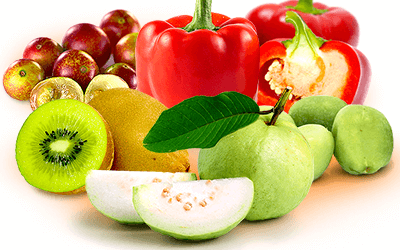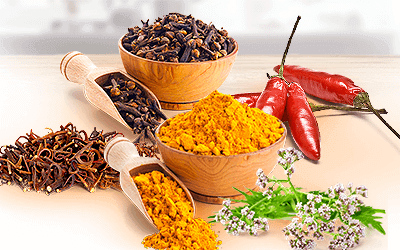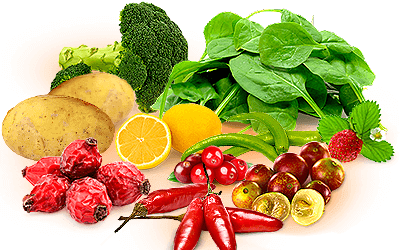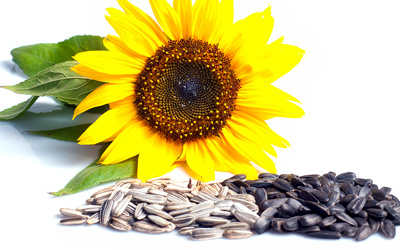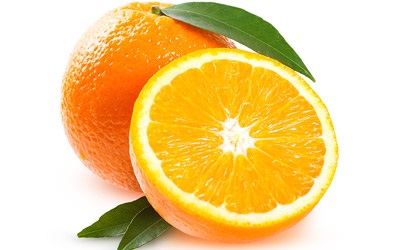Chili peppers, or Capsicum frutescens, are South American natives that have risen to the status of one of the world's most beloved and well-known spices because of their flavor and pungent taste. However, chili peppers are also a powerhouse of medicinal benefits, which have been successfully used for millennia to treat common health conditions, from headaches to joint pain and sore muscles.
Chili Pepper Medicinal Properties
- Medicinal action Analgesic, Hypocholesterolemic
- Key constituents Capsaicin, dihydrocapsaicin
- Ways to use Capsules, Food, Powder, Ointment
- Medicinal rating (3) Reasonably useful plant
- Safety ranking Safe
Health Benefits of Chili Peppers
Chili peppers offer many benefits, being the most important their anesthetic and hypocholesterolemic properties. This popular spicy herb has found a variety of medicinal applications, such as:
Inhibiting pain. Thanks to its analgesic properties, chili peppers help relieve the acute pain caused by arthritis and diabetic neuropathy.
Lowering blood cholesterol levels. The active compounds in chili peppers contribute to increase blood flow and improve fat metabolism, thus protecting cardiovascular health.
Furthermore, extensive research been done during the last two decades to determine the benefits of chili peppers in the treatment of gastric ulcers and weight lost.1
Chili peppers have been traditionally used to clear airways and stimulate bowel movements.
How It Works
THE INITIAL INFLAMMATORY PAIN OF CHILI PEPPERS IS QUICKLY FOLLOWED BY AN ANESTHETIC EFFECT.
Analgesic properties are also present in coffee and devil's claw, whereas avocado and olive help keep cholesterol levels in check.
Chili Pepper Side Effects
Chili pepper is considered safe to be ingested. However, people sensitive to capsicum may experience runny nose, stomach discomfort, sweating and skin redness. If consumed on a daily bases, capsicum can cause damage in liver or kidneys.
Cautions
During pregnancy and breast-feeding capsicum can be applied topically but is recommended to ingest it in moderation, since it may cause pre-eclampsia in pregnant women and dermatitis in the infants.
While further studies are required to confirm if capsicum consumption by mouth is safe for children under two, it is strongly advised not to use it on children's skin.
Capsicum should not be applied on damaged or broken skin.
Because of its anticoagulant properties, consuming capsicum is contraindicated in case of surgery. Its use should be completely suspended at least two weeks before the medical procedure.

Chili Pepper Nutrition
Chili peppers are an excellent source of vitamin C (ascorbic acid), a water-soluble nutrient that is essential for the biosynthesis of collagen and proteins. Vitamin C also plays an important role in immune function, protecting the body from diseases, and improves the absorption of the iron present in plant-based foods.
These spicy vegetables also provide good amounts of vitamin B6 (pyridoxine), which is necessary for normal brain development and function, for the production of serotonin and norepinephrine (two important hormones that regulate mood), and for the metabolism of melatonin, which helps modulate sleep patterns, as well as for the proper absorption of vitamin B12, the production of new red blood cells, and the well-functioning of the immune system.
The nutritional profile of chili peppers is rounded up by fair amounts of copper and vitamin K (phylloquinone), along with small quantities of many other vitamins and minerals that contribute to maintain overall health.
A single chili pepper (45 g) provides 18 calories, as well as 2% and 3% of the daily value for protein and dietary fiber, respectively.
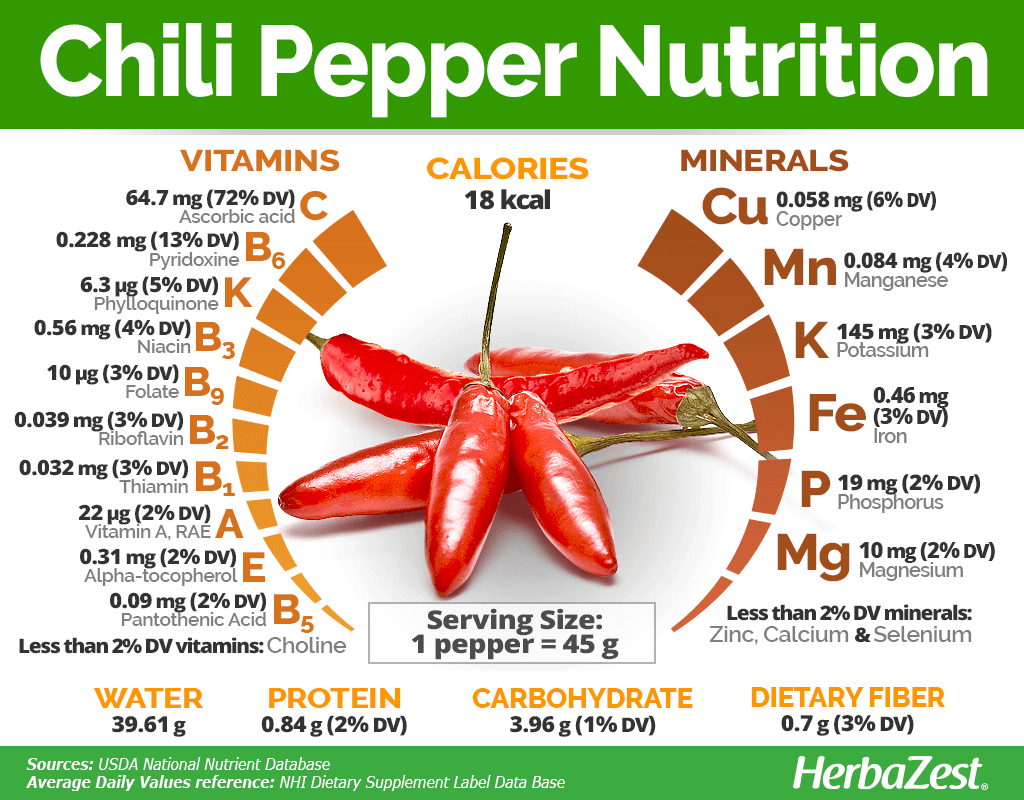
How to Consume Chili Pepper
- Edible parts Fruit
- Edible uses Condiment
- Taste Spicy
The most effective way of obtaining the medicinal benefits from chili peppers is using them as remedies, while their nutritional value is better absorbed through food. Most chili pepper supplements come in tablet or cream forms, and are mostly used as local anesthetics or for specific skin conditions.
Natural Forms
Raw. The nutritional value of chili peppers and its pungent flavor are fully preserved when consumed fresh. Sliced chili peppers can be added to salads, sprinkled over food, or blended with avocados for a spicy dip.
Cooked. When cooked, chili peppers lose a bit of their pungent capsaicin thus can be better tolerated for people with sensitive stomachs. However, their digestive and cholesterol-lowering properties still beneficial.
Pickled. A very popular way to extend the life of capsicum, pickling is also an effective method to preserve some of its nutritional content, such as A and E vitamins, and also its medicinal benefits. Pickled chili peppers can be used for both garnishing and cooking.
Powder. Dehydrated and finely ground chilli pepper has a longer shelf life and can be used to season a variety of dishes. It delivers all the health benefits of chili pepper, but with a slightly milder pungency.
Herbal Remedies & Supplements
Cream. Clinical trials have shown that, when topically applied, the analgesic properties of capsicum cream effectively reduces pain associated with arthritis.
Capsules. Taking capsicum capsules is the most effective way to reap the cholesterol-lowering effects of chili peppers.
Buying
- Where to buy Supermarkets, Big online retailers, Farmers' markets, Specialized health stores, Online herb stores
Natural Forms
Raw chili pepper is easy to find in most grocery stores or local markets around the world. The most common presentations of raw chili pepper include the whole fruit and powdered chilli. Dehydrated chili peppers are not as common but may still be found in specialized stores or ethnic markets.
Herbal Remedies & Supplements
Chili pepper supplements are mainly found in specialized health stores. These are growing in popularity due to capsaicin's pain-relieving ability, and there is a wide variety of chili pepper supplement choices available through online retailers. Each brand of chili pepper supplement may come with different concentrations, although they are overwhelmingly more common in tablet form and made from either powdered chili peppers or isolated capsaicin.
Growing
- Life cycle Perennial
- Harvested parts Fruit
- Light requirements Full sun
- Soil Light (sandy), Well-drained
- Soil pH 5.6 – 6.0 (Moderately acidic), 6.1 – 6.5 (Slightly acidic)
- Growing habitat Subtropical regions
- Growing time 5 months
- Potential insect pests Fungi
- Potential diseases Phytophthora spp.
Chili pepper is a perennial shrub that produces a fruit known for its strong, spicy flavor. It grows usually less than three feet (1 m) tall, with small, white, pendent flowers and elongated, yellow, orange or red fruits (berries). It can be distinguished from other types of domesticated peppers by flowers that are solitary rather than in groups, and filaments (thread-like stalks supporting the anther) that are not purple.
Growing Guidelines
Chili peppers grow better with temperatures between 60 - 70°F (16 - 21°C) and full sun exposure.
Five months of warm climate and bright sunshine are required for a chili pepper plant to produce berries, whose bright color and flavor are directly linked to the amount of sun exposure and heat.
Chili peppers require well-drained soil or low-retention, sandy soil. The pH should range between 5.5 and 6.5.
The chili pepper plant is very susceptible to root diseases such as Phythophthora spp. and other fungi infestations.
Additional Information
- Other uses Repellent
Plant Biology
The chili pepper is an annual plant originally native to tropical America. It has a thin, erect stem and narrow, glossy green leaves that grow from the branches. The chili pepper flowers can grow either alone or in clusters and they are star-shaped, with five lobes that can be white, green, or purplish. The chili pepper fruits, which are green but turn into glossy red as they ripe, have an elongated shape and are considered berries because they carry multiple seeds.
Classification
The scientific name for chili pepper is Capsicum frutescens, and it is a member of the Solanaceae family, also known as the nightshade family, which contains approximately 2,700 species of flowering plants, most notably potato (Solanum tuberosum), tomato (Solanum lycopersicum), eggplant (Solanum melongena), and cayenne (Capsicum anuum).
The genus Capsicum comprises 27 species and it is set apart because the presence of capsaicinoids, organic compounds that provide color and flavor to the fruits. The Latin name Capsicum derives from the Greek kapto meaning 'to bite' - in reference to the pungency of the chili pepper fruit.
Varieties and Cultivars of Chili Pepper
Over the course of history, over 300 types of peppers of different flavors, shapes, and colors have been cultivated or created through selective breeding in different regions of the world. Among the different varieties of chili peppers, the 'Tabasco', 'Malagueta', 'Piri piri' ('African devil'), and 'Kambuzi' peppers are the most widespread. Likewise, another notable cultivar of chili pepper is the 'Infinity chili', which was briefly considered in 2011 as the world's hottest pepper.
THE SPANISH WORD "CHILE" IS A VARIATION OF "CHIL", DERIVED FROM THE NAHUATL (AZTEC), REFERRING TO PLANTS THAT BELONG TO THE CAPSICUM GENUS.
Historical Information
A perennial herb that grows best in subtropical regions, chili pepper was not discovered by Europeans until the colonization of the Americas, although researchers believe it was a staple food in the New World as far back as 6,000 years ago. Interestingly, the food's status as a medicinal agent - most notably, as an antiseptic and painkiller - seems to be even more ancient, as it is thought to have preceded its use as food source.
Some researchers point out that it may have been first discovered around 8,500 BCE. The importance of chili peppers was magnified after the Discovery and Conquest when they were rapidly disseminated and adapted to different regions worldwide.
Popular Beliefs
A native tribe of Panama - the Kuna people - uses chili peppers today in a ceremony that takes place when a girl begins puberty. The peppers are burned and the smoke that is released is believed to drive away evil spirits.
Economic Data
Chili peppers are of great economic importance in agriculture and gastronomic industries and are considered one of the most used spices worldwide. According to aggregate estimates by the Food and Agriculture Organization (FAO), during the last five years alone, worldwide production of chili peppers has risen from 28 million tonnes to over 32 million tonnes.
India is currently the world's largest exporter, consumer, and producer of chili peppers. Within India, one state alone, Andhra Pradesh, contributes 70% of the country's chili exports.
Other Uses of Chili Pepper
Repellent. Chili peppers are often used in Africa and South Asia as a repellent to protect crops from elephants.
Self defense. Chili pepper is also used in the production of pepper spray, a non-lethal defensive weapon.
Sources
- Critical Reviews in Food Science and Nutrition, Capsaicin and gastric ulcers, 2006
- Culpeper's Complete Herbal, Guinea Pepper
- Molecules, Chemical and Pharmacological Aspects of Capsaicin, 2011
- New Mexico State University, Chile Pepper Institute, Nutritional Information
- Encyclopedia of Herbal Medicine, p. 78
- FAOSTAT, Chillies and Peppers, green: Production report
- NCCAM Herbs at a Glance, : Complementary Health Approaches for Chronic Pain, 2014
- Kew Royal Botanic Gardens, Capsicum annuum (chilli pepper)
- Science Magazine, Starch fossils and the domestication and dispersal of chili pepper (Capsicum spp. L. ) in the Americas, 2007
Footnotes:
- Clinical Nutrition Journal. (2009). Effects of capsaicin, green tea and CH-19 sweet pepper on appetite and energy intake in humans in negative and positive energy balance. Retrieved March 4, 2024, from: https://pubmed.ncbi.nlm.nih.gov/19345452/
- PLoS One. (2014). A capsaicin (8%) patch in the treatment of severe persisitent inquinal postherniorrhapaty pain a randomized, double-blind, placebo-controlled trial. Retrieved march 4, 2024, from: https://www.ncbi.nlm.nih.gov/pmc/articles/PMC4188585/
- Clinical Therapeutics. (1991). Treatment of arthritis with topical capsaicin: a double-blind trial. Retrieved march 4, 2024, from: https://pubmed.ncbi.nlm.nih.gov/1954640/
- Nutrients. (2017). Capsaicin Supplementation Improved Risk Factors of Coronary Heart Disease in Individuals with Low HDL-C Levels. Retrieved march 4, 2024, from: https://www.ncbi.nlm.nih.gov/pmc/articles/PMC5622797/
